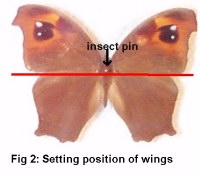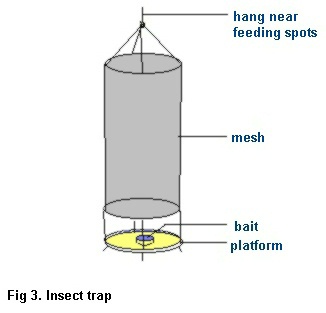The collection of Lepidoptera (butterflies and moths) is very rewarding.
View my collection of South African Lepidoptera and some
that I have collected in Gabon by clicking
on the tabs on the navigation bar on the left hand side of the page.
For collecting you need the following basics:
Net for capturing
Mounting boards
Entomological pins
Storing space (cabinet,
boxes, etc.)
Net
The net bag should
be made of soft material to prevent damage to the wings. It should be slightly longer than your arm length with a width of
0.5 to 0.9 m. Essentially the bag should be 0.3 m longer than the width so that it can be flipped over the net hoop when capturing.
Hoops can be made from aluminium, steel or wire and connected to a bamboo stick or aluminium pipe.
Mounting Boards
To "set"
the butterfly, a mounting board is used (Fig 1). These can be made from balsa wood, cork or polystyrene. When constructing
a mounting board, take into consideration the length of an insect pin, keeping in mind that the butterfly is pinned so that
only 1/4 or 1/3 of the pin is exposed above the body. Boards can be constructed to be flat or angled at 5 -10° from
the horizontal.

Entomological pins
Entomological
pins are graded in sizes from No. 00 to 5 (fine to thick). Usually the No. 2 or 3 size is sufficient to pin most butterflies.
The pin is inserted vertically through the center of the thorax so that it extrudes on the underside slightly behind the middle
pair of legs. After pinning, the upper wing bases are mounted in the form of a straight line (Fig 2). Wings are gently moved
in position with a pin or setting needle and are held in place with setting strip (plastic strips, tracing or greaseproof
paper ext) and pins as seen in Fig 1. Allow enough time for the specimen to dry completely.

Storage
Pinned insects
should be kept in the dark in order to retain their colour. Museum beetles and mites must be kept out of stage cabinets and
boxes, by using moth balls (naphthalene) or insect repellent strips. Containers must seal well, cardboard boxes are
sufficient, as long as the insect repellent is checked, and replaced regularly. Wooden boxes with glass lids can be constructed
and are ideal for display.
Trapping
Some butterflies,
like the Charaxes species, are attracted to fermenting fruit. Bait can be prepared by fermenting ripe mashed bananas
(mango, pineapple, pawpaw) with a few teaspoons of brown sugar and a little hot water or rum for a few days. Bait is placed
in hanging traps (Fig 3.) to attract the insects.

Classification of southern
African butterflies
1. Family: Nymphalidae, subfamily
Danainae - milkweed butterflies
2. Family: Nymphalidae, subfamily Satyrinae
- browns
3. Family: Nymphalidae, subfamily Araeinae - acraeas
4. Family: Nymphalidae, subfamily Nymphalinae - nymphs, commodores
5. Family:
Nymphalidae, subfamily Charaxinae - charaxes
6. Family: Libytheidae
- snout butterflies
7. Family: Lycaenidae - blues and coppers
8. Family: Pieridae - whites
9. Family: Papilionidae - swallowtails
10. Family: Hesperiidae - skippers

